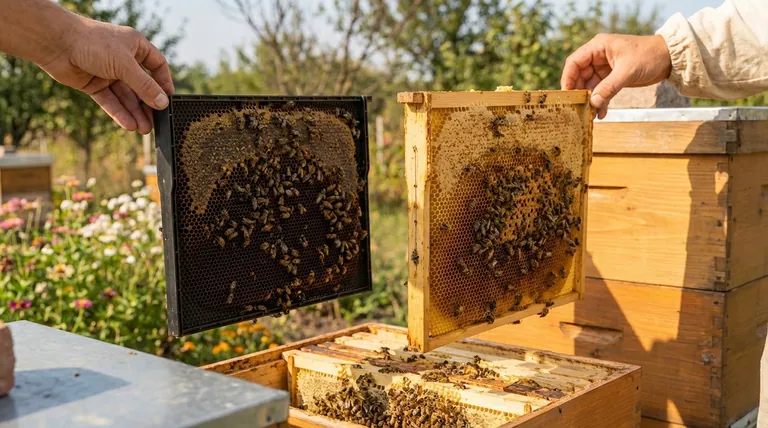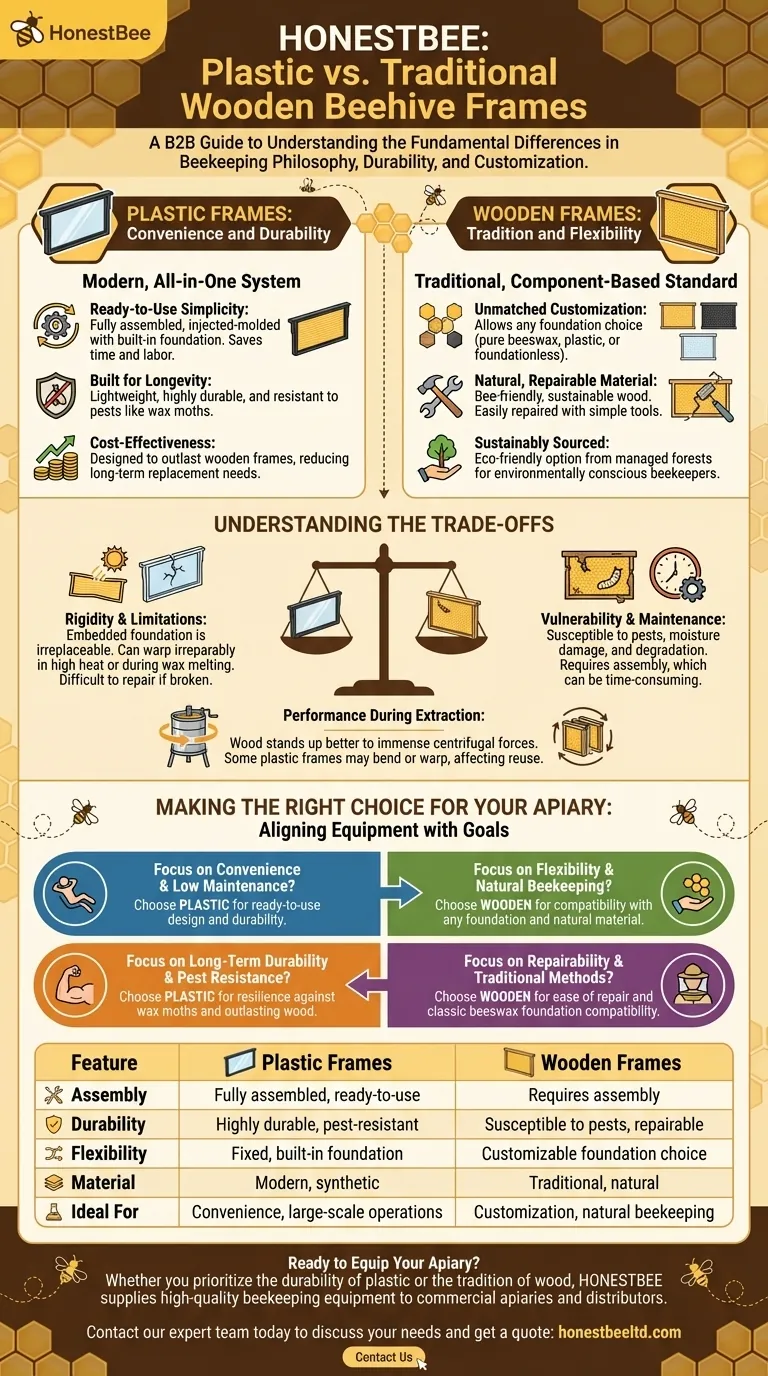At their core, plastic and wooden beehive frames serve the same purpose but represent fundamentally different philosophies of beekeeping. Plastic frames are a modern, all-in-one system prized for convenience and durability, arriving fully assembled with a built-in plastic foundation. Wooden frames are the traditional, component-based standard, offering unmatched flexibility in foundation choice and a more natural, repairable material for the hive.
The choice between plastic and wood is not about which is universally "better," but about aligning your equipment with your specific goals. You are choosing between the operational efficiency and longevity of plastic versus the customization and natural appeal of wood.

The Case for Plastic: Convenience and Durability
Plastic frames are engineered for a streamlined beekeeping experience, prioritizing ease of use and long-term resilience.
Ready-to-Use Simplicity
Plastic frames are typically injected-molded as a single piece, complete with a built-in plastic foundation. This means they arrive fully assembled and ready to be placed directly into the hive, saving significant time and labor.
The foundation often comes pre-stamped with a cell pattern and coated with a thin layer of wax to encourage bees to start building comb.
Built for Longevity
A key advantage of plastic is its durability. These frames are more lightweight than their wooden counterparts, making them easier to handle and move, especially when full of heavy honey.
They are also highly resistant to pests like wax moths, which cannot burrow into or consume solid plastic as they can with wood and wax foundation.
Cost-Effectiveness
While the initial price may be comparable, plastic frames are generally considered more cost-effective over their lifespan. They are designed to outlast wooden frames, reducing the need for frequent replacements.
The Appeal of Wood: Tradition and Flexibility
Wooden frames are the established standard in beekeeping, valued for their natural composition and adaptability.
Unmatched Customization
The primary strength of a wooden frame is its flexibility. Unlike the integrated design of plastic, a wooden frame allows a beekeeper to use any type of foundation—from pure beeswax and plastic inserts to none at all for natural comb.
This makes wood the only choice for beekeepers who want to use a traditional pure beeswax foundation or practice foundationless beekeeping.
A Natural, Repairable Material
Many beekeepers believe wood is more bee-friendly, as it's a natural material that bees adapt to quickly. If a wooden frame breaks, it can often be easily repaired with simple tools, glue, and nails.
Furthermore, wooden frames can be sourced from sustainably managed forests, offering an eco-friendly option for the environmentally conscious beekeeper.
Understanding the Trade-offs
Neither frame material is without its drawbacks. Acknowledging these limitations is critical for making a well-informed decision.
The Rigidity of Plastic
The all-in-one design of plastic frames is also their main limitation. The embedded plastic foundation cannot be replaced, locking you into a single system.
In very hot climates or during solar wax melting, plastic frames can warp irreparably. If a plastic frame breaks, it is significantly more difficult to repair than wood.
The Vulnerability of Wood
Wooden frames require more maintenance. They are susceptible to damage from pests like wax moths and can degrade over time, especially in damp conditions.
Most wooden frames also require assembly, which can be a time-consuming process for beekeepers managing many hives.
Performance During Honey Extraction
The extraction process places immense centrifugal force on the frames. Wooden frames are known to stand up well against these forces.
In contrast, some plastic frames have been known to bend or warp after extraction. This can make them difficult to place back into the hive and reuse for subsequent honey flows.
Making the Right Choice for Your Apiary
Your beekeeping philosophy and operational needs should guide your decision.
- If your primary focus is convenience and low maintenance: Choose plastic frames for their ready-to-use design and durability.
- If your primary focus is flexibility and natural beekeeping: Choose wooden frames for their compatibility with any foundation and natural material.
- If your primary focus is long-term durability and pest resistance: Choose plastic for its resilience against wax moths and its ability to outlast wood.
- If your primary focus is repairability and traditional methods: Choose wooden frames for their ease of repair and classic compatibility with beeswax foundation.
Ultimately, understanding these core differences empowers you to select the frame that best aligns with your goals and management style.
Summary Table:
| Feature | Plastic Frames | Wooden Frames |
|---|---|---|
| Assembly | Fully assembled, ready-to-use | Requires assembly |
| Durability | Highly durable, pest-resistant | Susceptible to pests, repairable |
| Flexibility | Fixed, built-in foundation | Customizable foundation choice |
| Material | Modern, synthetic | Traditional, natural |
| Ideal For | Convenience, large-scale operations | Customization, natural beekeeping |
Ready to Equip Your Apiary with the Right Frames?
Whether your commercial operation prioritizes the durability and convenience of plastic frames or the flexibility and tradition of wooden frames, HONESTBEE has the wholesale supplies you need. We supply high-quality beekeeping equipment to commercial apiaries and distributors, helping you maximize efficiency and honey production.
Contact our expert team today to discuss your specific needs and get a quote on the best frames for your beekeeping goals.
Visual Guide

Related Products
- Plastic Bee Frame Beekeeping Hive Frames for Wholesale
- Assembled Wooden Bee Frames with Plastic Foundation for Durability and Convenience by HONESTBEE
- 7 x Auto Bee Flow Hive Frames Plastic Beekeeping Hive Box Supplies
- Heavy-Duty Stainless Steel Clip-On Frame Perch
- 3.5L Plastic Beehive Frame Feeder Deep Frame Water Feeder for In Hive Use
People Also Ask
- Can you boil plastic bee frames? Avoid This Costly Mistake and Protect Your Hive
- Are plastic frames good? Boost Apiary Efficiency with Durable, Pest-Resistant Frames
- What are the advantages of plastic frames for beehives? Boost Apiary Efficiency & Durability
- What is a general rule for beekeepers with many hives regarding frame choice? Maximize Efficiency with Plastic Frames
- Can beekeepers switch between wooden and plastic frames? Optimize Your Hive's Performance



















